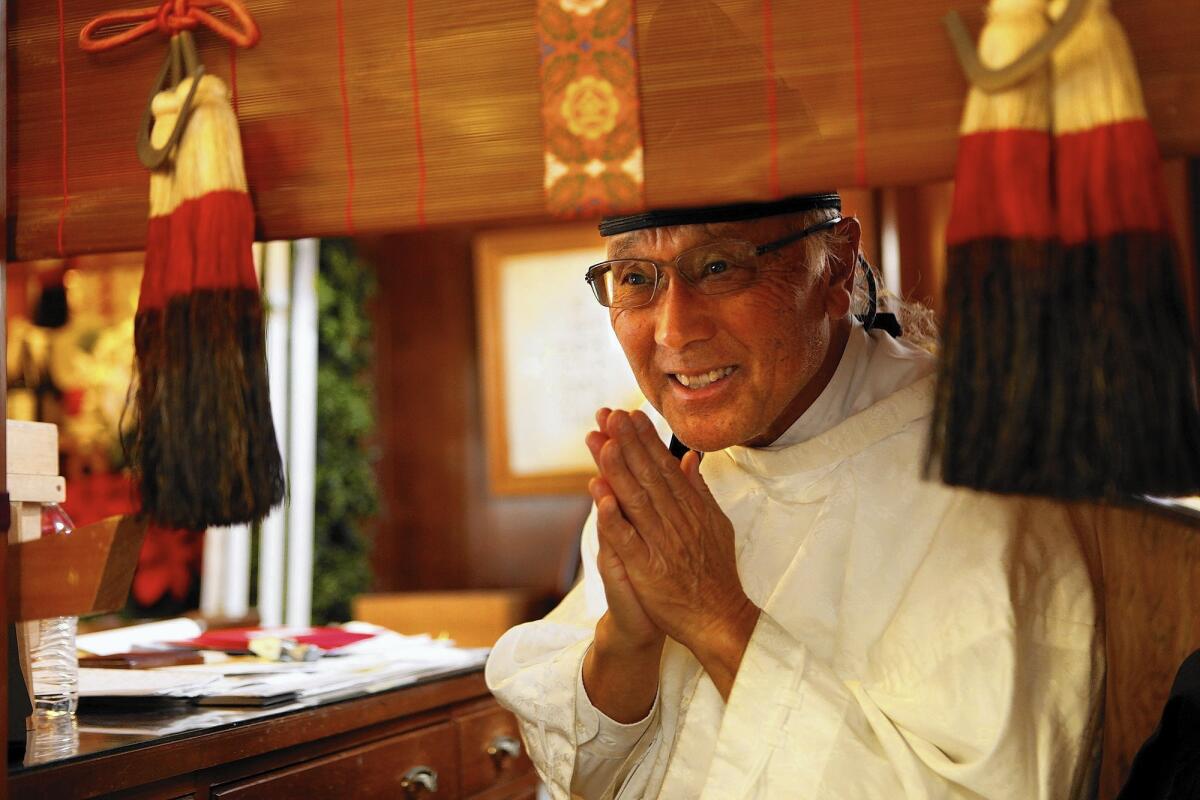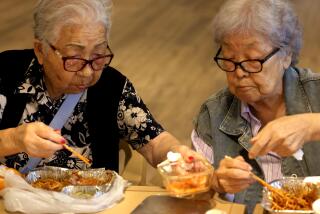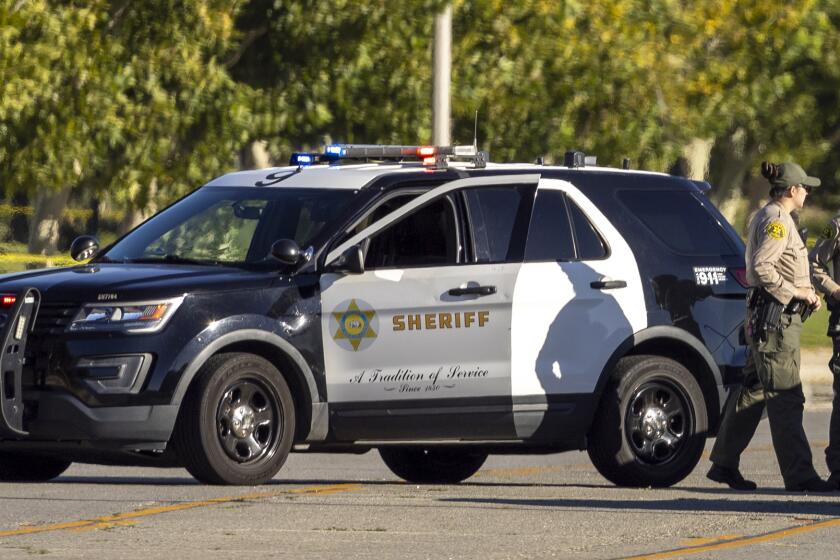In Boyle Heights, Japanese churches look to broaden their membership

- Share via
The service begins with four loud claps. Two reverends in white robes and black ceremonial caps face each other and chant, alternating between English and Japanese.
Two children quietly chatter to their parents in the back of the church. Several parishioners come to the front and present sakaki tree branches to the spirits. In addition to the mostly Japanese parishioners, several white congregants bow their heads, joining in the clapping and orations.
There are only about 60 people at one of Konko Church of Los Angeles’ biggest services, the Autumn Grand Ceremony.
Konko Church is one of the four remaining Japanese churches in Boyle Heights, a largely Latino neighborhood once called home by diverse groups, including Jews, Italians, Russians and a large number of Japanese and Japanese Americans. As the neighborhood changed, the churches that were pillars of the Japanese American community have struggled to keep pace.
For decades now, Boyle Heights has been a cornerstone of Mexican and Mexican American culture in Los Angeles, and the country. But within its urban landscape are hints of its past — a star of David on a building converted into an evangelical church or the renovated Breed Street Shul; an Italian American who can regale with stories about his childhood in a once polyglot neighborhood.
The most obvious markers of Boyle Heights’ diverse past are, perhaps fittingly, its numerous cemeteries: Chinese, Serbian, Jewish, Japanese.
But although most of these other groups have disappeared — or are laid to rest in its soil — a tiny Japanese American community survives. Of the estimated 84,000 residents in Boyle Heights, about 100 are of Japanese ancestry.
They are an unusual enough sight to stand out — like the churches, which have remained a constant, even if their membership has declined.
Konko is next door to El Rinconcito del Mar restaurant. La Fe medical clinic stands nearby at the corner of East 1st Street and Evergreen Avenue. Only a handful of establishments — Haru Florist, the Rafu Chuo Gakuen Japanese-language school, Otomisan restaurant — offer clear evidence of the world Konko used to inhabit.
Before World War II, Boyle Heights had the largest community of Japanese Americans in Southern California. Japanese-owned grocery stores dotted the street alongside a Japanese hospital, and several churches were established in the 1920s and ‘30s, like Konko.
“Everyone spoke Japanese because they were from Japan,” said Ikuko Yuge, a reverend at Tenrikyo Church.
Konko Church practices the earliest form of Japanese religion — Shintoism — a cultural, spiritual tradition focusing on interaction with the forces of the universe. Shinto traditions are widely practiced in Japan. Women visit shrines to pray for safe pregnancies; children have coming-of-age ceremonies there.
Services at Boyle Heights’ Japanese churches came to a halt during World War II when President Franklin D. Roosevelt’s Executive Order 9066 forced Japanese Americans into internment camps. Ministers and priests, in particular, were perceived as “dangerous” and sent to relocation camps away from their families.
The people were gone, but the church buildings were cared for by non-Japanese neighbors. Tenrikyo Mission Headquarters, located on East 1st and Saratoga streets, became home to an African American Christian congregation. Konko was adopted by a local Latino family, who held evangelical services on the property.
After the war, the churches became temporary homes, more physical than spiritual, for the many returning Japanese Americans who had lost their own while they were interned.
The Rev. Alfred Tsuyuki of Konko said he remembered living at Tenrikyo for a couple of days with his family after the camps closed.
“Having been accommodated by Tenrikyo, my father never forgot their graciousness,” he said.
By the 1950s, Boyle Heights was home to six churches geared toward Christian, Buddhist and Shinto parishioners of Japanese descent. As Japanese Americans settled back in Boyle Heights, the churches flourished again. Nichiren Buddhist Temple, then located on East 3rd Street, had to enlarge its property in 1970 to its current location at 4th Street and Saratoga streets to accommodate its peak membership of 600, the Rev. Join Inoue said.
During the same time, Rissho Kosei-Kai, a Buddhist offshoot, outgrew its location in a private home and bought the Higashi Hongwanji Buddhist temple next to Tenrikyo, after the congregation of one of the oldest Buddhist temples in Los Angeles decided to move the church to Little Tokyo.
But Japanese Americans continued to move out of Boyle Heights. Many loyal churchgoers were now miles away in Gardena, Torrance and Orange County. As many got older, the commute became too long. One church left Boyle Heights to be closer to parishioners in the San Gabriel Valley.
Inoue said he’s thought about relocating the temple closer to its members, maybe in Orange County, but said there’s no serious plans in place. In Japan, temples don’t move from where their foundations were originally laid.
“In Japan, generations will be tied to a particular temple … and nobody wants to be the one in that long string of generations to cut the tie,” said Noriaki Ito, head minister of Higashi Hongwanji Buddhist Temple and a Boyle Heights native. “In the U.S., that tradition doesn’t exist.”
Some churches like Rissho Kosei-Kai and Tenrikyo Mission Headquarters get financial support from their main offices in Japan, allowing them to maintain steadfast, if smaller congregations. But both also draw much, if not most, of their parishioners from elsewhere. Rissho Kosei-Kai gets some congregants from Lompoc and San Diego, and Tenrikyo attracts people from New York and Canada for some of its monthly services.
But to survive, religious leaders say, they have to reach out to the neighborhood that their churches have called home for generations, regardless of the changed demographics.
Rissho Kosei-Kai installed a large, illuminated sign on 1st Street announcing that “everyone is welcome.” Tenrikyo has a minister that speaks Spanish and has a few Latino members. Konko hosts a martial arts class in its sanctuary that brings in neighborhood youth.
“We will take care of Japanese Americans that want to pray with us,” Inoue of Nichiren said. “At the same time, this is not a Japanese American community center, but a religious organization. We should receive and be welcome to any kind of people who want to pray with us, to join our family.”
More to Read
Sign up for Essential California
The most important California stories and recommendations in your inbox every morning.
You may occasionally receive promotional content from the Los Angeles Times.














